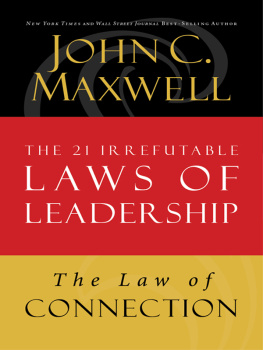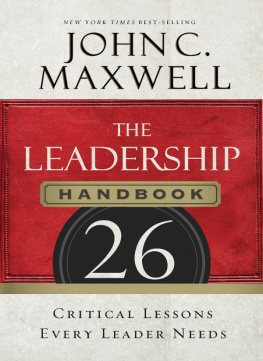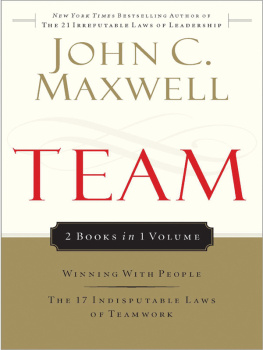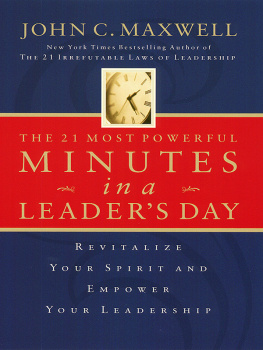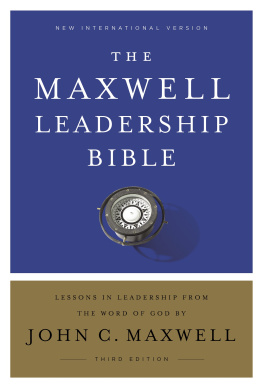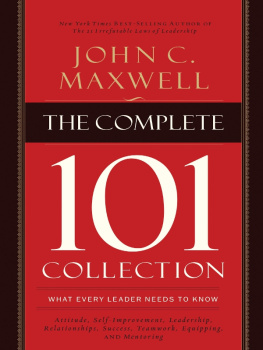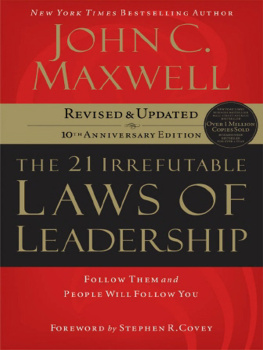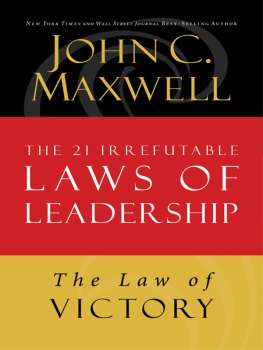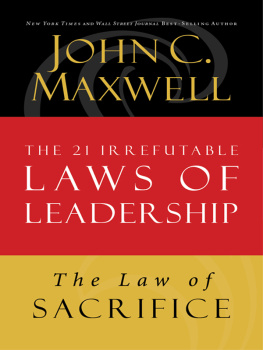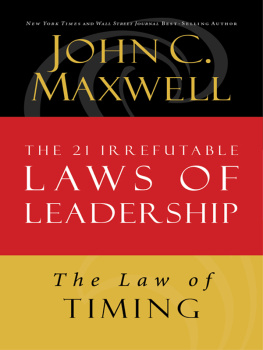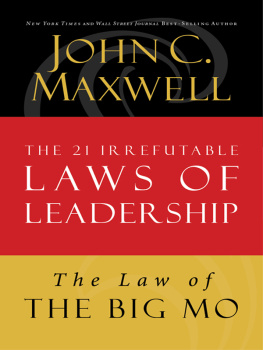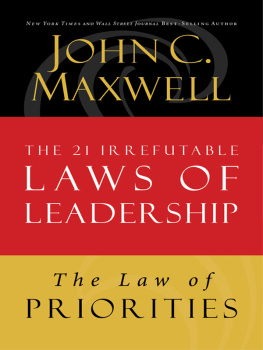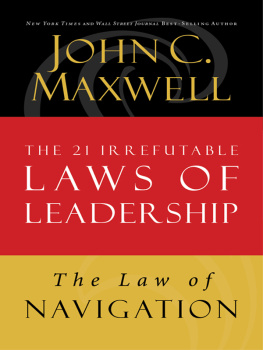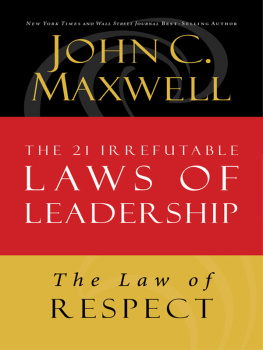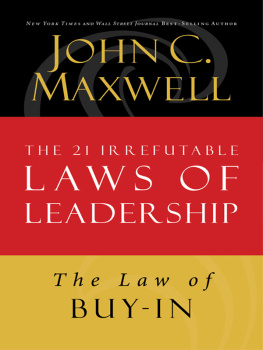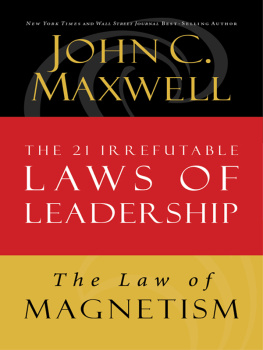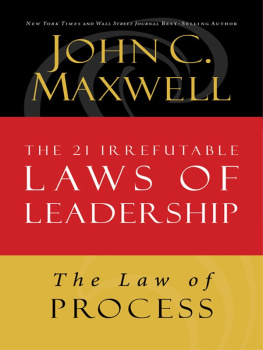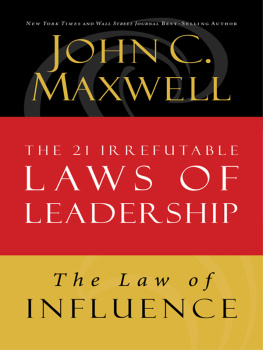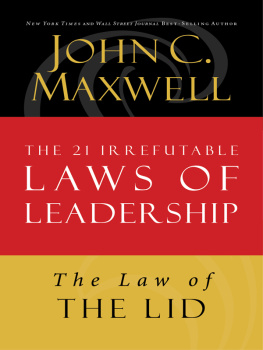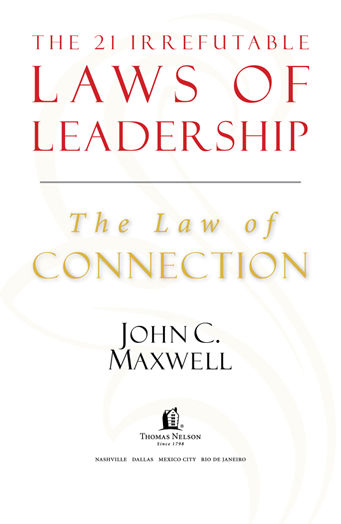
1998 and 2007 by John C. Maxwell
This ebook is derived from The 21 Irrefutable Laws of Leadership, by John Maxwell, 1998 and 2007 by Maxwell Motivation, Inc., a Georgia corporation.
All rights reserved. No portion of this book may be reproduced, stored in a retrieval system, or transmitted in any form or by any meanselectronic, mechanical, photocopy, recording, scanning, or otherexcept for brief quotations in critical reviews or articles, without the prior written permission of the publisher.
Published in Nashville, Tennessee, by Thomas Nelson. Thomas Nelson is a trademark of Thomas Nelson, Inc.
Thomas Nelson, Inc. titles may be purchased in bulk for educational, business, fund-raising, or sales promotional use. For information, please e-mail SpecialMarkets@ThomasNelson.com.
Published in association with Yates & Yates, LLP, Attorneys and Counselors, Orange, California.
Scripture quotations noted CEV are from THE CONTEMPORARY ENGLISH VERSION.
1991 by the American Bible Society. Used by permission.
Scripture quotations noted The Message are from The Message: The New Testament in Contemporary English. 1993 by Eugene H. Peterson.
ISBN 978-0-7852-7431-5 (HC)
ISBN 978-1-4185-3831-6 (ebook)
ISBN 978-1-4002-7569-4 (ebook of Chapter 10)

This book is dedicated to Charlie Wetzel, my writing partner since 1994. Together weve written more than forty books, and Ive enjoyed our collaboration on every one. As I have labored to add value to others by identifying and teaching leadership principles, Charlie, you have added value to me and my efforts. Your insights and skills as a wordsmith have been enjoyed by millions of readers. As a result, you have made a greater impact on more people than has anyone else in my inner circle. For that I thank you.
CONTENTS


Thank you to the thousands of leaders around the world who learned and sometimes challenged the laws of leadership, thus sharpening my thinking.
Thank you to the team at Thomas Nelson who gave me the chance to revise and improve this book, and especially to Tami Heim for her strategic leadership and to Victor Oliver who was instrumental in the development of the original concept.
Thank you to Linda Eggers, my executive assistant, and her assistant, Sue Caldwell, for their incredible service and willingness to go the extra mile every day.
Thank you to Charlie Wetzel, my writer, and Stephanie, his wife, with-out whose work this book would not have been possible.

Leaders Touch a Heart Before They Ask for a Hand
There are incidents in the lives and careers of leaders that become defining moments for their leadership. In the perception of followers, the general public, and historians, those moments often represent who those leaders are and what they stand for. Heres an example of what I mean. I believe the presidency of George W. Bush can be summed up by two defining moments that he experienced during his time in office.
A CONNECTION MADE
The first moment occurred early in his first term, and it defined that entire term in office. On September 11, 2001, the United States was attacked by terrorists who crashed planes into the World Trade Center and Pentagon. People in the United States were angry. They were fearful. They were uncertain about the future. And they were in mourning for the thousands of people who lost their lives to the terrorists.
Just four days after the collapse of the World Trade Center towers, Bush went to Ground Zero. He spent time there with the firefighters, police officers, and rescue workers. He shook hands. He listened. He took in the devastation. He thanked the people working there and told them, The nation sends its love and compassion to everybody whos here. Reports said that the spirits of the tired searchers lifted when the president arrived and started shaking hands.
Cameras captured Bush standing in the wreckage with his arm around firefighter Bob Beckwith. When some members of the crowd shouted that they couldnt hear him, Bush called back, I can hear you. The rest of the world hears you. And the people who knocked these buildings down will hear all of us soon. The people cheered. They felt validated. They felt understood. Bush had connected with them in a way no one had seen him do prior to that moment.
NOBODYS HOME
The second incident came during Bushs second four years in office, and it defined that second term. It occurred on August 31, 2005, just two days after the landfall of Hurricane Katrina. After the levees in New Orleans broke and water flooded into the city, instead of visiting the city as he did in New York after 9/11, Bush flew over New Orleans in Air Force One, peering through one of the jets small windows to see the damage. To the people of the Gulf Coast, it was a picture of indifference.
As the tragedy unfolded, no one in authority at any level of government connected with the people of New Orleans: not the president, not the governor, not the mayor. By the time Mayor Ray Nagin ordered the citys evacuation, it was too late for many poor residents to leave. He sent people to the Superdome, advising them to eat before they went because the local government had made no provisions for them. Meanwhile, he held press conferences and complained that he wasnt getting any help. And the people most affected by the problems felt abandoned, forgotten, and betrayed.
After the worst of the tragedy was over, no matter what President Bush said or how much help he provided, he was unable to regain the peoples confidence and trust. Its true that when democratic Mayor Nagin was reelected less than a year after the disaster, he thanked Bush for delivering for the citizens of New Orleans. And Donna Brazile, another Democrat, has since described Bush as very much engaged in the rebuilding process and praised him for prompting Congress to dedicate money to rebuilding the levees. But by then Bush could not undo the image of indifference he had created. He had failed to connect with the people. He had broken the Law of Connection.
THE HEART COMES FIRST
When it comes to working with people, the heart comes before the head. Thats true whether you are communicating to a stadium full of people, leading a team meeting, or trying to relate to your spouse. Think about how you react to people. If you listen to a speaker or teacher, do you want to hear a bunch of dry statistics or a load of facts? Or would you rather the speaker engaged you on a human levelmaybe with a story or joke? If youve been on any kind of winning team in business, sports, or service, you know that the leader didnt simply give instructions and then send you on your way. No, he or she connected with you on an emotional level.
For leaders to be effective, they need to connect with people. Why? Because you first have to touch peoples hearts before you ask them for a hand. That is the Law of Connection. All great leaders and communicators recognize this truth and act on it almost instinctively. You cant move people to action unless you first move them with emotion.
Next page
